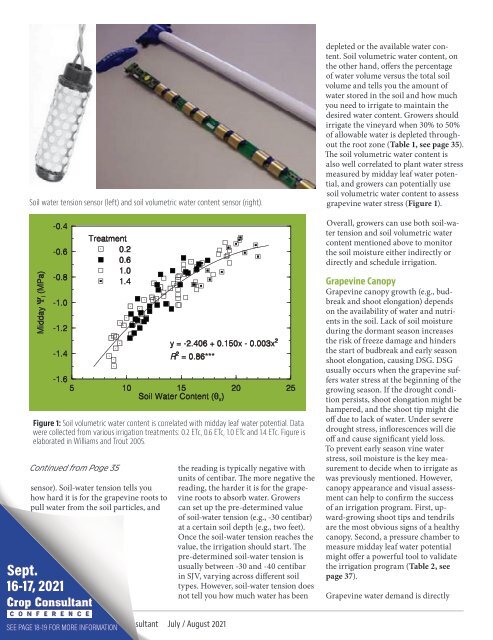PCC June July 2021 e
Create successful ePaper yourself
Turn your PDF publications into a flip-book with our unique Google optimized e-Paper software.
Soil water tension sensor (left) and soil volumetric water content sensor (right).<br />
depleted or the available water content.<br />
Soil volumetric water content, on<br />
the other hand, offers the percentage<br />
of water volume versus the total soil<br />
volume and tells you the amount of<br />
water stored in the soil and how much<br />
you need to irrigate to maintain the<br />
desired water content. Growers should<br />
irrigate the vineyard when 30% to 50%<br />
of allowable water is depleted throughout<br />
the root zone (Table 1, see page 35).<br />
The soil volumetric water content is<br />
also well correlated to plant water stress<br />
measured by midday leaf water potential,<br />
and growers can potentially use<br />
soil volumetric water content to assess<br />
grapevine water stress (Figure 1).<br />
Overall, growers can use both soil-water<br />
tension and soil volumetric water<br />
content mentioned above to monitor<br />
the soil moisture either indirectly or<br />
directly and schedule irrigation.<br />
Figure 1: Soil volumetric water content is correlated with midday leaf water potential. Data<br />
were collected from various irrigation treatments: 0.2 ETc, 0.6 ETc, 1.0 ETc and 1.4 ETc. Figure is<br />
elaborated in Williams and Trout 2005.<br />
Continued from Page 35<br />
sensor). Soil-water tension tells you<br />
how hard it is for the grapevine roots to<br />
pull water from the soil particles, and<br />
Sept.<br />
16-17, <strong>2021</strong><br />
the reading is typically negative with<br />
units of centibar. The more negative the<br />
reading, the harder it is for the grapevine<br />
roots to absorb water. Growers<br />
can set up the pre-determined value<br />
of soil-water tension (e.g., -30 centibar)<br />
at a certain soil depth {e.g., two feet).<br />
Once the soil-water tension reaches the<br />
value, the irrigation should start. The<br />
pre-determined soil-water tension is<br />
usually between -30 and -40 centibar<br />
in SJV, varying across different soil<br />
types. However, soil-water tension does<br />
not tell you how much water has been<br />
Grapevine Canopy<br />
Grapevine canopy growth (e.g., budbreak<br />
and shoot elongation) depends<br />
on the availability of water and nutrients<br />
in the soil. Lack of soil moisture<br />
during the dormant season increases<br />
the risk of freeze damage and hinders<br />
the start of budbreak and early season<br />
shoot elongation, causing DSG. DSG<br />
usually occurs when the grapevine suffers<br />
water stress at the beginning of the<br />
growing season. If the drought condition<br />
persists, shoot elongation might be<br />
hampered, and the shoot tip might die<br />
off due to lack of water. Under severe<br />
drought stress, inflorescences will die<br />
off and cause significant yield loss.<br />
To prevent early season vine water<br />
stress, soil moisture is the key measurement<br />
to decide when to irrigate as<br />
was previously mentioned. However,<br />
canopy appearance and visual assessment<br />
can help to confirm the success<br />
of an irrigation program. First, upward-growing<br />
shoot tips and tendrils<br />
are the most obvious signs of a healthy<br />
canopy. Second, a pressure chamber to<br />
measure midday leaf water potential<br />
might offer a powerful tool to validate<br />
the irrigation program (Table 2, see<br />
page 37).<br />
Grapevine water demand is directly<br />
SEE PAGE 36 18-19 FOR MORE Progressive INFORMATION Crop Consultant <strong>July</strong> / August <strong>2021</strong>

















